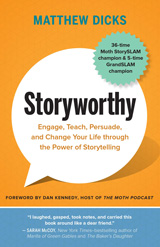Storyworthy: Engage, Teach, Persuade, and Change Your Life through the Power of Storytelling
| Matthew Dicks, 2018
What’s It All About?
This book came to me from my writing partner Brian Herriot, who said it took his storytelling to the next level. After reading it, I can see why it came so highly recommended.
Matthew Dick’s Storyworthy sharpened the way I think about every story I tell — whether on a stage as a keynote speaker, in a boardroom coaching manufacturing leaders, or on my Mindfulness Manufacturing podcast. As I continue to work on my own book and support leaders in manufacturing, Storyworthy reminds me that storytelling isn’t a skill just for writers. It’s for anyone who wants to connect, influence, and lead through meaningful moments.
Storyworthy breaks storytelling into three parts:
- Finding
- Crafting
- Telling your story
What stood out to me is how Matthew Dicks doesn’t treat storytelling like theater. Instead of acting, you’re revealing something real. Even if it’s something small and smile, it still holds an emotional weight that will shift something inside your listeners.
Great stories come from change, not performance. And when you share a story, you’re always the protagonist. Even if someone else’s actions drive the moment, it’s your version of the experience—and how it impacted you—that really counts.
Favorite Quotes
“My life becomes brighter and sharper and better with every memory that is uncovered. The reason is simple; We are the sum of our experiences, the culmination of everything that has come before.”
Biggest Takeaway
I love the concept of “homework for life.” This simple habit alone could make you a millionaire in stories. Every day, capture one small moment. That’s it. It could be a look from someone, a comment, or something unexpected you noticed. These become your story vault. I now keep a quick-hit list and can already see how much I’ve forgotten until I jog the memory. It’s like building your own personal archive of five-second moments, which I can use to make story truly resonate.
I only wish I’d started this practice years ago!
Bonus Information
- Keep it short. A six-minute story beats a ten-minute one. If you know your ending (your “five-second moment”), then you’ll know what your beginning should be: the opposite.
- Tense matters. Present tense puts your audience in the moment. You only slip into past tense for backstory.
- Don’t perform—connect. Speak like you would at a dinner table. Memorize your beats, not your words.
- Use “but” and “therefore.” They create surprise and zig-zag motion. “And” just drags a story along.
- Create a movie in the mind. Avoid pulling the audience out of the scene. Skip commentary like “you won’t believe this” and set every moment in a clear location.
- Failures > Successes. People connect more to the struggle than the victory. Keep the leaps small and the actions specific.

